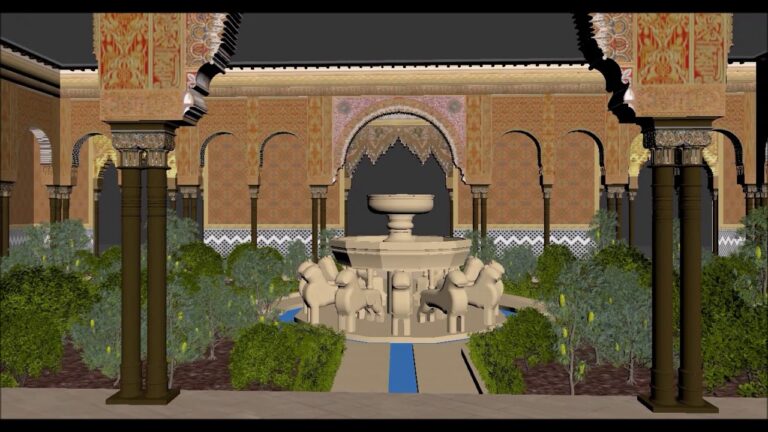The Court of Lions in the Alhambra is one of the most famous and visited places in Granada, Spain. It is located inside the Nasrid Palace, which is part of the famous World Heritage Site of Alhambra. The Court of Lions has become an icon of Granada and its architecture is a masterpiece of Islamic art.
History of the Court of Lions
The Court of Lions was built in the 14th century by Yusuf I and Mohammed V of the Nasrid dynasty, and was completed in the 15th century. It was designed as a place for the royal family to relax and enjoy their leisure time. The name of the court comes from the twelve marble lions which form a circle around a central fountain, each lion holding a replica of a golden ball.
The Court of Lions was not only a place of leisure, but also a symbol of power and strength. The twelve marble lions were a representation of the twelve tribes of Israel and were used to symbolize the power of the Nasrid dynasty.
Architecture of the Court of Lions
The Court of Lions is an example of Islamic architecture and is composed of three main elements: the lions, the fountain and the surrounding arches. The twelve marble lions are arranged in a circle around the central fountain, which is decorated with intricate Islamic motifs. The surrounding arches are decorated with ceramic tiles in a variety of colors, and the ceiling is covered in intricate geometric patterns.
The Lions
The twelve marble lions are the most striking feature of the Court of Lions. Each lion is carved from a single block of marble and stands about two meters tall. The lions are arranged in a circle around the central fountain, each one holding a replica of a golden ball. The lions are thought to represent the twelve tribes of Israel, and were used to symbolize the power of the Nasrid dynasty.
The Fountain
The central fountain is the centerpiece of the Court of Lions. It is decorated with intricate Islamic motifs and is made from white marble. The fountain is surrounded by four marble columns, each of which is decorated with ceramic tiles in a variety of colors. Water flows from the fountain into a shallow pool, which is surrounded by marble benches.
The Arches
The surrounding arches are decorated with ceramic tiles in a variety of colors, and the ceiling is covered in intricate geometric patterns. The arches are thought to represent the twelve gates of paradise, and the ceiling is thought to represent the heavens.
Conclusion
The Court of Lions in the Alhambra is an iconic example of Islamic architecture and is one of the most visited places in Granada, Spain. It was built in the 14th century by Yusuf I and Mohammed V of the Nasrid dynasty, and is composed of three main elements: the lions, the fountain and the surrounding arches. The twelve marble lions are arranged in a circle around the central fountain, which is decorated with intricate Islamic motifs. The surrounding arches are decorated with ceramic tiles in a variety of colors, and the ceiling is covered in intricate geometric patterns. The Court of Lions has become an icon of Granada and its architecture is a masterpiece of Islamic art.
